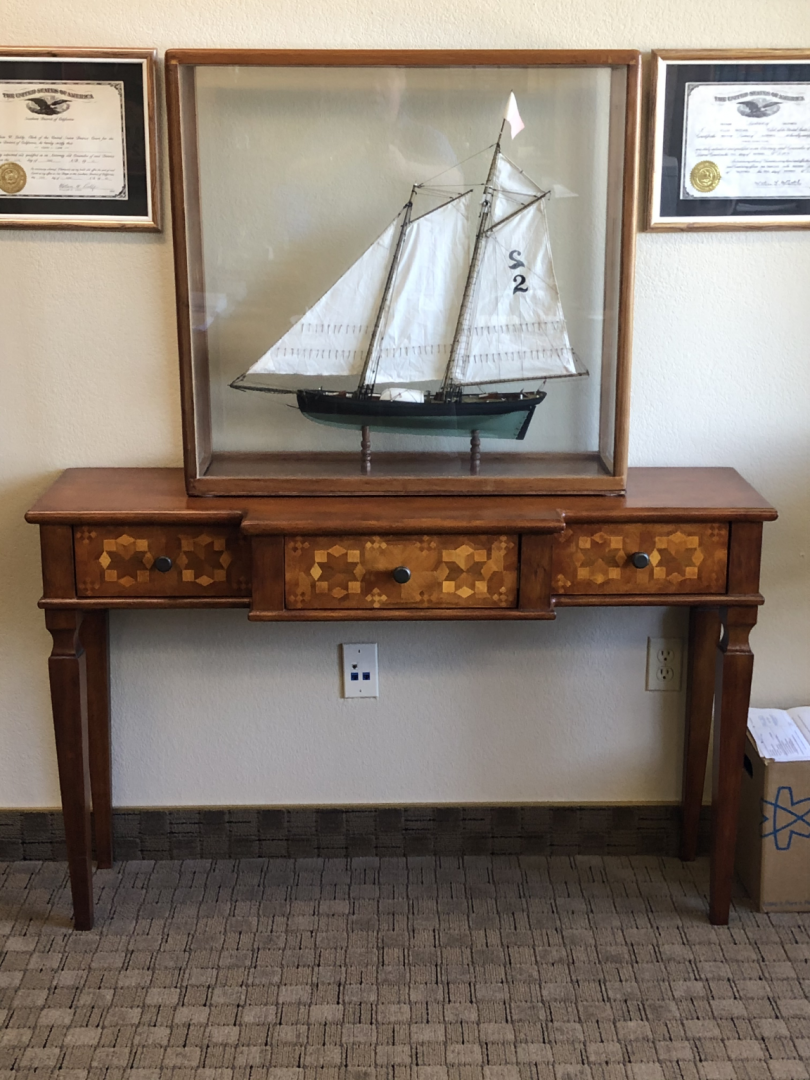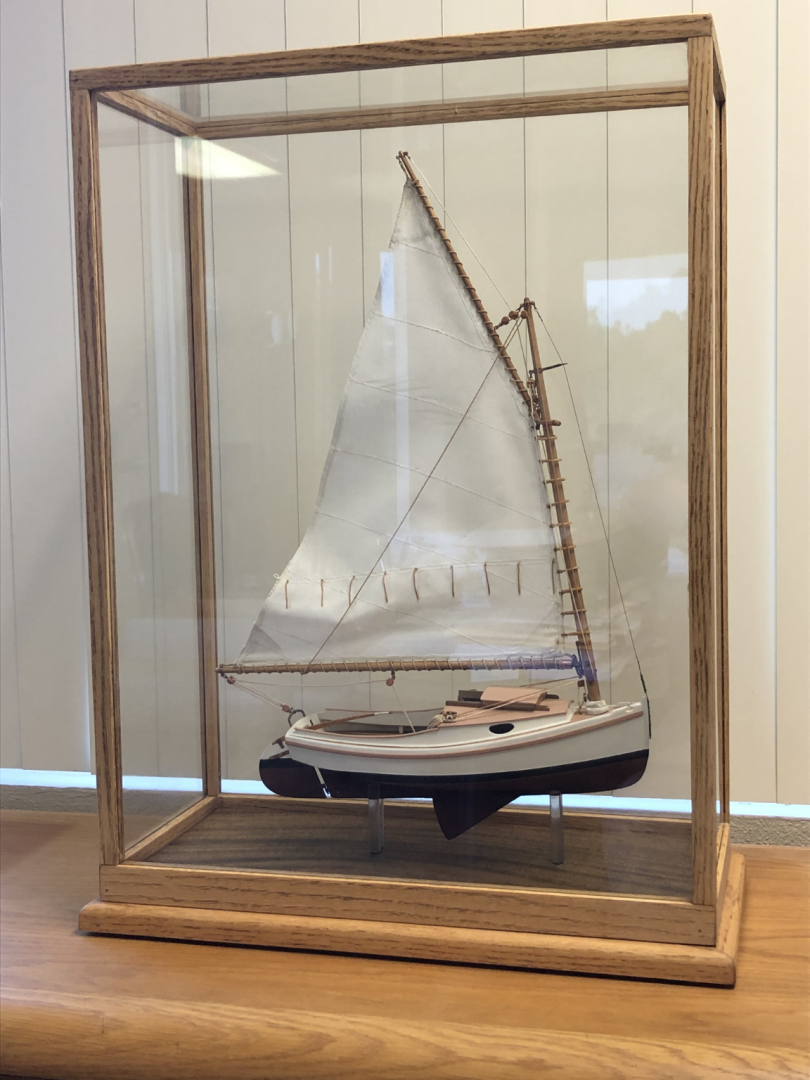
Bob Cleek
-
Posts
3,374 -
Joined
-
Last visited
Content Type
Profiles
Forums
Gallery
Events
Everything posted by Bob Cleek
-
Hi Oakvander,
I'm located in Petaluma, CA, just north of San Francisco. I've spent my life in the maritime community here (my dad was in the shipping business with American President Lines.) I've been involved with other models folks sought to donate to the local museums through my connections with the late Karl Kortum, the founder of the San Francisco Maritime Museum. (I am an attorney by profession and a local maritime historian by avocation.) I've been building ship models on and off, as well as building, sailing, and maintaining my own wooden yachts for over fifty years. I've studied ship models "in person" in maritime museums in the U.S. and Europe. While I don't consider myself a "professional" in the field, I have to say that I can't imagine there is any museum that would be interested in accepting this model for any purpose other than to sell it off to a decorator or auction house, which for their purposes, would not be worth the effort because of the cost to restore it to marketable condition may well exceed the value of the model itself once it's restored. This isn't to suggest the model is "worthless," but only that those in the business of buying and selling models are looking to make a profit and little else. Moreover, the model is of a vessel with absolutely no local connection, so museums wouldn't be interested. Finally, as is becoming apparent from the posts in your thread, the model itself has no remarkable provenance, although we do know it appears to be a copy of the 16th Century NMG model whose prototype itself cannot be identified.
As someone mentioned, there may be a library, a yacht club, or a waterfront bar that might be interested in it for use as decor, but I doubt any of these would pay money for it nor provide an IRS deductible donation receipt for it for anything more than the statutory $500 maximum limit without a written appraisal for it that satisfied the IRS requirements. Here again, none of these would be interested in the model unless it was restored, the cost of which would far exceed the amount of any net recovery from a charitable donation deduction.
Another problem with selling models is that they are very expensive to ship anywhere because their cases must be properly crated to prevent breakage and they require very special handling by specialist shippers. They rarely survive a long-haul ride in the back of a semi-trailer. Here again, the shipping and special handling costs could well exceed the market value of the model, so the market area is likely to be limited to local buyers.
If the above discouraging assessment proves to be the case after their further efforts, I'd hate to see this otherwise nicely built model end up in the back of a Goodwill truck or the like. As I have done with deserving models before, I would be happy and grateful to "give it a good home," and restore it for my own "collection," which is hardly what anyone would call "museum quality," but interesting nonetheless. I hate to see well-build models die. However, the economics of it all being that the most I can justify offering for the model is to restore, preserve, and and appreciate it. If that it appears to the owners to be the best option left to them, I'd be happy to have it.
If you or they wish to discuss it further with me, you can contact me at robert@cleek-elin.com or phone at 415-408-8464.
BOB CLEEK
- Show previous comments 13 more
-
Hi Bob. Thanks for your input. It sure seems like the same model to me.
It's not known how it got here. One of the former owners of the house where the model is currently was a bigwig at Barclays, which is based in London. I imagine he could easily have afforded to have it shipped by the most expensive means possible. But I don't know whether it was the guy from Barclays who brought it into the house or another former owner, an architect.
It's been a fun research project. I've enjoyed learning about the world of ship models. Hopefully the owners will decide the fate of the model soon.
-
I also wanted to mention that Dr. Kriegstein suggested that the fact that the model was built by John Franklin is unlikely to change the price estimate significantly. Yet, one of the other forum members just replied indicating that it could. Your thoughts?
You mentioned previously that Mr. Wall has a gallery where he sells models. I wasn't aware of that until you told me. So, if we got him to do an appraisal, might he make an offer to purchase it (seems like a potential conflict of interest)? Also, would he expect the owner to ship the model to him? They're probably not going to want to do that.
-
Ah... The Barclay's Bank connection is a possible explanation. Being a San Francisco native, I recall Barclay's Bank back in those days. It was a British bank that opened a US subsidiary. They marketed themselves as "ever so veddy British" and played on the cache' that they were somehow "higher class." (Remember this was the era when James Bond was considered the ultimate in "cool," instead of the quaintly misogynistic lout he appears to be in his old movies today.) A model like this would exactly be the sort of thing they would have in their SF financial district branch office or conference room. Banks used to have fancy lobbies when customers had to spend time waiting in line for a teller back before ATM machines. (Wells Fargo had (has?) a stage coach and company museum in their Montgomery Street branch lobby around the same era.) I wouldn't be a bit surprised if some executive took it home when there was a move and it was no longer needed... or would no longer be noticed missing.

I agree with Dr. Kriegstein that the fact Franklin built the model wouldn't change the value appreciably. As a model, it is what it is and it does have its limitations. Franklin was known as a collector and an authority on Navy Board models, but he was not known as a model builder. His being the builder should definitely be told to Wall if an appraisal is done. it's not insignificant, but, while of interest, I also don't see anybody paying more for it on that account. I greatly respect the forumite who made the comment that it may increase the value, but I'm afraid his goodwill and best wishes got ahead of him in that instance. There are really only five or eight ship model builders in the world alive at any time whose works are so highly regarded and well recognized that their handiwork automatically draws attention in the marketplace. Ship models are like any work of art: They don't realize their highest prices until the artist is dead!

Yes, Wall does sell models, although at this point is seems that he also is doing a fair amount of appraisals, consulting, and restoration and conservation work. I've noticed of late that the quality and price point of his gallery offerings has decreased somewhat in recent years. He used to have a fair number of fine older models of high quality, along with some works by well known contemporary master modelers, but of late it seems he's filled out his offerings with less interesting stuff, including simply nicely made kit models! He still apparently has two or three of the well-recognized professional modelers who seem to sell their works through his gallery. Here's his current inventory you haven't seen it already: Current Inventory – American Marine Ship Model Gallery
I don't know if Wall accepts models for sale on commission or buys them outright and sells them on his own account.. He doesn't hold auctions, as far as I know. I would expect that he would want the model in his gallery if he were going to try to sell it. Any buyer would want to at least see a model in person before buying and a wise collector paying a good price for a select model would probably want it professionally examined and appraised.
Bob






